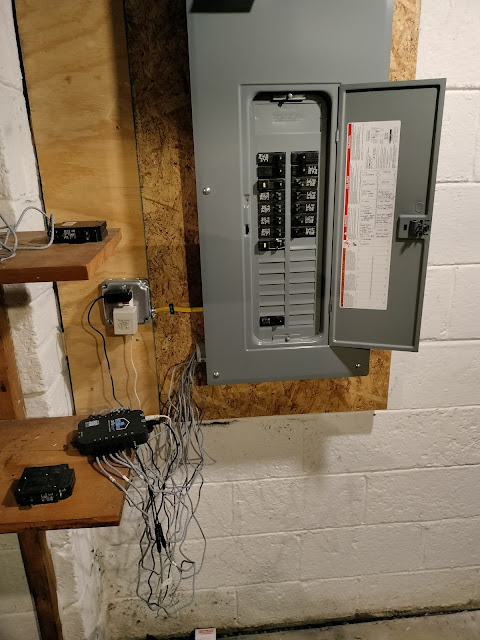Background
The other day I happened to be reading through my post about how often the classic rock station in Philly, WMGK, plays different songs. I noticed that that post was made 10 years ago, on August 26, 2013. That made me wonder how things may have changed since then and how much work it would be to scrape their recently played page again to collect the data. I was sure my old code wouldn't work, but figured I'd take a look at the page and see how hard it'd be to write something new.
It didn't take long to realize this was the one gift every scraper lives in hope of: Their front end was just hitting an open API to get the data. The network tools showed the request:
https://nowplaying.bbgi.com/WMGKFM/list?limit=200&offset=0
Which returns a nicely formatted JSON list of the 200 most recently played songs. That would make it trivial to collect this data, but it got even better. If you noticed the offset parameter there, this was pretty much just letting me get data directly out of their database. I tested it, and sure enough, I could just page through the data to go back as far as I tested (a few months). This meant I could get the full 60 days worth of data, for the exact same time period as I used in 2013, instantly.
I whipped up some code real quick to do the scraping, and store the data in a basic SQLite database. I want to mention here that I'm increasingly a fan of using SQLite for storing data for these types of quick projects. Don't get me wrong, I still wished I had a real database a dozen times when writing queries in this project, and wouldn't use SQLite for an actual application, but the alternative here is CSV files, not a full Postgres database. And when compared to CSV files, there's no contest. Being able to write SQL, and being able to decide to expand the scope and add a few more tables later on, while still having those relations represented is very nice. And from the other side, using SQLite means you still have a file you can easily share like a CSV file. With the expected audience of this post, I probably don't have to spend any more time arguing that databases are good, so I'll stop here.
I also want to say that while I was doing the scraping, I was very paranoid they would realize what I was doing and cut me off at any moment. That is, until I realized there was no way anyone in the world cared about this data besides me, and there was no one watching a dashboard live seeing the spike in queries and immediately launching into action to prevent the scraping of their priceless WMGK recently played data.
So what does WMGK play?
With that all out of the way, how does WMGK in 2023 compare with WMGK in 2013? I was able to look at the exact same date range as in 2013, June 26th to August 24th, or 60 days.
In my previous post I compared what WMGK played with what the most popular songs by those bands were on Last.fm a lot. I'm not doing any of that here. You can refer to the graphs from that post if you want to see what the most popular songs by bands are, but here I'm focused on how WMGK has changed in 10 years.
I would assume that they are playing more recent bands, and perhaps have retired some of the older bands they used to play. Philly still has a Rock station in WMMR though, so I would think their might be a more older bias still on the Classic Rock station. Also WMGK (and WMMR) were bought in 2016 by the Beasley Media Group, which I assume is ran by Pam from The Office. Might the new owners prefer more variety? Conglomerates buying and consolidating industries usually results in a better product, right?
Coverage
To review, in 2013 WMGK played 14,286 songs during the 60 day period, of which 924 were unique. But of those unique songs, there was a clear trend where a few dozen got played daily or every other day, and then they occasionally threw in a "deep" cut (which likely wasn't that deep). The best summary of that fact, was that just 172 songs represented half of those 14,286 plays over 60 days.
In 2023 WMGK played 15,190 songs during the same 60 day period (6/26/2023 to 8/24/2023), of which 1060 were unique. So far so good, that is better than last time, albeit not much. Really the question is how distributed are those songs. Is it the same as last time, where the same handful of songs get played constantly? In a word, yes.
Here's the coverage breakdown.
| 2013 |
|
2023 |
| Coverage |
Songs |
|
Coverage |
Songs |
| 10.04% |
28 |
|
10.30% |
31 |
| 25.27% |
77 |
|
25.02% |
79 |
| 50.23% |
172 |
|
50.03% |
168 |
| 75.13% |
279 |
|
75.10% |
275 |
| 90.03% |
373 |
|
90.01% |
381 |
| 100.00% |
924 |
|
100.00% |
1060 |
To review what I mean by "coverage" this is the number of songs you'd need to represent x% of plays. In other words, there's a 25% chance that any random song you heard on WMGK was one of the top 79 songs they play. If anything, it's striking how similar those numbers are. The only noticeable difference is a slightly longer tail of songs they played once.
Top Songs
So, things aren't looking good for 2023 WMGK, but let's look closer. What were the top songs played in 2023 vs 2013? The first table is sorted by top songs in 2013, and the second is top songs in 2023.
| Plays/30 days (2013) |
Band |
Song |
Plays/30 days (2023) |
| 27.5 |
Warren Zevon |
Werewolves Of London |
0 |
| 27 |
Cars |
Just What I Needed |
26.5 |
| 27 |
Blue Oyster Cult |
Burnin' For You |
22 |
| 27 |
Steve Miller Band |
Rock 'n Me |
26 |
| 26.5 |
Supertramp |
The Logical Song |
23.5 |
| 26.5 |
David Bowie |
Changes |
18 |
| 26.5 |
Pink Floyd |
Another Brick In The Wall |
21.5 |
| 26.5 |
Electric Light Orchestra |
Do Ya |
0 |
| 26 |
J. Geils Band |
Centerfold |
25.5 |
| 26 |
War |
Low Rider |
25.5 |
|
|
|
|
| Plays/30 days (2013) |
Band |
Song |
Plays/30 days (2023) |
| 0 |
Survivor |
Eye Of The Tiger |
27.5 |
| 0 |
Outfield |
Your Love |
27.5 |
| 4.5 |
Allman Brothers Band |
Ramblin' Man |
26.5 |
| 27 |
Cars |
Just What I Needed |
26.5 |
| 1 |
Eddie Money |
Take Me Home Tonight (Be My Baby) |
26.5 |
| 14 |
Pete Townshend |
Let My Love Open The Door |
26 |
| 27 |
Steve Miller Band |
Rock 'n Me |
26 |
| 16.5 |
Fleetwood Mac |
Go Your Own Way |
25.5 |
| 22 |
Guess Who |
American Woman |
25.5 |
| 26 |
J. Geils Band |
Centerfold |
25.5 |
Obviously, I expected changes, but it is surprising how many songs went from 0 plays in 2013 to top 10 song in 2023 or vice versa. While I don't have anything against Eye of the Tiger, it doesn't strike me as a particularly "Classic Rock" song. Admittedly, there's some association with Philly due to Rocky, but still, it's an odd top song.
However, it's time to discuss the biggest travesty I discovered while looking through the 2023 data. You may have noticed that Warren Zevon's Werewolves of London went from the #1 song, with 27.5 average plays in 30 days, down to 0 plays across 60 days. That is bad enough, however, one of the new bands to be played in 2023 was Kid Rock. He had a single play for a song called "All Summer Long", which I decided to listen to to see if it qualified as Classic Rock. Well I'm guessing most people reading this are ahead of me on the punchline, but that song is the one were he "samples" the Werewolves of London intro.
So, to review: If you were listening to 102.9 WMGK, the Classic Rock station from June 26th 2023 to August 24th 2023, and you heard the Werewolves of London intro, we can say with absolute certainty that what you were actually hearing was Kid Rock. Our ancestors weep.
I'm hesitant to even link to the Kid Rock song, but if you aren't familiar with it, here it is. After you watch 5 seconds of that, please switch to the Werewolves of London video, and tell me that isn't an objectively better video.
Top Bands
Well, I don't even know if there's any point in going on, but for what it's worth, here's the top bands.
| Plays (2013) |
Band |
Plays (2023) |
Change |
| 356.5 |
Rolling Stones |
251.5 |
-105 |
| 334.5 |
Led Zeppelin |
252 |
-82.5 |
| 283 |
Beatles |
69.5 |
-213.5 |
| 183 |
Pink Floyd |
147.5 |
-35.5 |
| 177.5 |
Who |
82 |
-95.5 |
| 169.5 |
Van Halen |
130 |
-39.5 |
| 164 |
Queen |
135.5 |
-28.5 |
| 154.5 |
Journey |
161.5 |
7 |
| 143 |
Cars |
71.5 |
-71.5 |
| 138.5 |
Billy Joel |
178 |
39.5 |
|
|
|
|
|
|
|
|
| Plays (2013) |
Band |
Plays (2023) |
Change |
| 334.5 |
Led Zeppelin |
252 |
-82.5 |
| 356.5 |
Rolling Stones |
251.5 |
-105 |
| 138.5 |
Billy Joel |
178 |
39.5 |
| 105 |
Elton John |
168.5 |
63.5 |
| 105.5 |
Aerosmith |
167 |
61.5 |
| 154.5 |
Journey |
161.5 |
7 |
| 135.5 |
Tom Petty & The Heartbreakers |
160 |
24.5 |
| 25.5 |
U2 |
148 |
122.5 |
| 183 |
Pink Floyd |
147.5 |
-35.5 |
| 77.5 |
Fleetwood Mac |
147 |
69.5 |
More similar than the top songs. Biggest changes are the dropping of Beatles and the rise of U2. Sorry, I can't think straight after that Kid Rock/Werewolves of London debacle. But let's perservere
Here's a graph of the top 50 bands.
And here's the 2013 version, for comparison.
Chart is pretty similar, although the top bands in 2023 are only getting 250 plays/month vs 350 for in 2013. The rest of the top tier bands got 150 plays/month in both 2013 and 2023.
Plays per hour of day
Here's a quick plays per hour chart.
And then the 2023 version.
Similar, but less of a clear pattern.
Top songs by band
This is the part of the post where I looked at a bunch of individual bands last time. I'm not really going to do that here, we already know MGK doesn't play a variety from any band, they just pick 2 or 3 hits and only play those. But I will post one comparison for one band.
That band is Yes, who admittedly are maybe not the best radio band, but they absolutely have plenty of Classic Rock hits. In 2013 MGK played I've Seen All Good People 22 times/month, and then occasional plays from "deep cuts" like Roundabout and a few others.
In 2023 MGK played only 2 Yes songs, one was Roundabout with 1.5 plays per month (down from 3.5 in 2013). The other got 25.5 average plays in 30 days, and that song was Owner of a Lonely Heart.
Now I like Owner of a Lonely Heart, just like I like every Yes song, but it is not the first song that comes to mind when I think of Classic Rock. At this point, I just want to say that I did go to WMGK's site and confirm that they still refer to themselves as a "Classic Rock" station, which they do. I just can't fathom the decision making here. I'd like to present this dramatization of how that decision may have been made.
"Ok, we need our single song for our Yes allotment for our Classic Rock station that we can play every single day"
"What if instead of playing the same Yes song every day we just choose from a handful of the best Yes songs?"
"You're fired, who's got my pick?"
"What era do people most associate with both 'classic rock' and the band Yes? The 80s right? So let's play the most 80s Yes song, Owner of a Lonely Heart"
"Perfect, let's go to lunch"
Changes in band makeup
Another thing I wanted to look at was what bands from 2013 were no longer played in 2023, and what bands were new in 2023. I don't think I ever gave this stat in my prior post, but in 2013 there were 172 distinct bands played. In 2023 that number has gone up to 293. Looking at a diff of the two, there aren't many that disappeared; a few that look like they did are just due to formatting changes, like replacing & with and, which I could clean up, but I'm not.
Skimming through the diff, the only bands I notice going away in 2023 are: Jefferson Airplane, The Animals, Yardbirds, and Zombies. Which are are all very 60s era bands, so I guess that makes sense. There's a ton of new 90s bands, which I can't say I agree with for a Classic Rock station, but that is far from the top problem.
"One hit" wonders
Finally, I attempted to answer the question, how many bands do they just play one song (or nearly one song) from? So to start with some high level stats. There were 293 distinct bands, and of those 78 were only played 1 time, leaving 215 bands that were played multiple times. Of those, there were 45 bands with at least 3 plays, yet only 1 song ever played. In addition to those 45 bands with only 1 song played multiple times, there were 33 more bands with multiple songs played, but where the top song was at least 80% of those plays. Finally, there are only 68 bands with at least 3 plays where the top song wasn't most (> 50%) of those plays.
I eyeballed the list of some of these groups, and two stood out to me from the list of bands where MGK played just 1 song by a band: Alice Cooper (School's Out), and Thin Lizzy (The Boys Are Back In Town). If we expand that list out to include bands with multiple songs, but where the top song was at least 80% of the plays then we get a lot more, including:
| Alice In Chains |
Man In The Box |
| Neil Young |
Rockin' In The Free World |
| Yes |
Owner Of A Lonely Heart |
| Allman Brothers Band |
Ramblin' Man |
| Electric Light Orchestra |
Evil Woman |
| Van Morrison |
Moondance |
| Rush |
Tom Sawyer |
Keep in mind these were just the bands that stood out to me as bands where I know they have a bunch of hits that could be played besides just one song.
Closing
I think the data speaks for itself (with the help of my multiple page essay you just read through): WMGK has not gotten better from 2013 to 2023, and in fact, has gotten much worse in some key areas. I'm curious what 2033 holds.
Also, for the record, I don't think I've listened to WMGK, or any radio station since my 2013 post. So maybe I have no room to talk, maybe the people listening to the radio in 2023 want to hear the same 80 songs on repeat every day forever.
Further Reading
As I mentioned above, I did a similar analysis in 2013, which you probably should have read before this post.
In the extraordinarily unlikely scenario that you want to scrape some WGMK recently played songs for yourself, the code is up on Github.
In the slightly less unlikely scenario you just want to play around with the data here is an unorganized spreadsheet with 10 tabs worth of data I used for this post. And here is the full SQLite database which includes some additional time than just the 60 days I focused on in this post.









